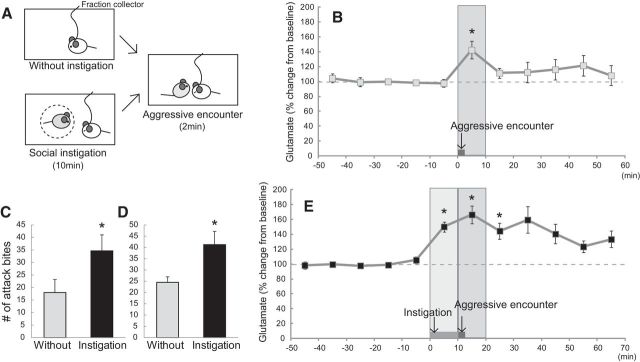Figure 4.
Glutamate release in the DRN evoked by aggressive encounter and instigation-heightened aggression. A, Schematics of the experiments. Top, Species-typical aggression (without instigation) group experienced only 2 min aggressive encounter with an intruder. Bottom, In social instigation group, a caged-instigator was introduced into the test cage of resident male for 10 min, and then an intruder male was introduced and stayed for 2 min. B, Aggressive encounter without instigation increased the glutamate level in the DRN. Each 10-min samples were collected: five samples for baseline, one sample for during and after aggressive encounter, and five further samples after aggressive encounter. Data are mean ± SEM expressed as percentage of baseline (n = 11); *p < 0.05 compared with baseline. C, Frequency of attack bites without and with social instigation before the surgery. The same resident males were tested for both without and with social instigation situations (n = 34, animals used for Experiments 6, 8, 9); *p < 0.05. D, The frequency of attack bites without and with social instigation during in vivo microdialysis experiment. Different animals were assigned to either without instigation group (n = 25, Experiments 5, 7) and instigation group (n = 23, Experiments 6, 8); *p < 0.05. E, Social instigation caused further increase of glutamate during aggressive encounter compared with without instigation (143% and 166% increase, without and with social instigation, respectively). Both social instigation and aggressive encounter increased glutamate level in the DRN. Each 10 min sample was collected: five samples for baseline, one sample for social instigation, one sample for during and after aggressive encounter, and five further samples after aggressive encounter. Data are mean ± SEM expressed as percentage of baseline (n = 10); *p < 0.05 compared with baseline.

